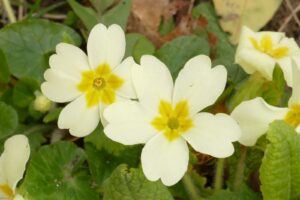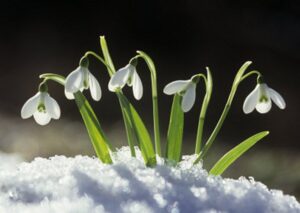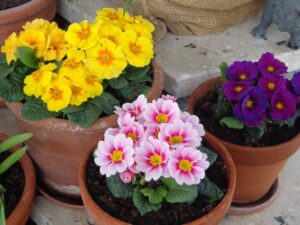Has spring arrived yet?
For some people the first signs are snowdrops appearing in the garden. Well, they are now beginning to appear, but it is certainly not officially spring yet – we are still well into winter, and all the wintry weather conditions that brings. However, spring flowers are starting to make an appearance in the garden, including snowdrops and members of the Primula family. These plants are all coming into the garden centres and nurseries right now and are an ideal way to brighten up containers.



What jobs should we be doing in February?
- Trim old flowers from winter flowering heather, to the base of the flower stalk, to encourage side shoots to form – otherwise they can become straggly and you can end up with a bare centre in the plant.
- Most grasses have had their foliage left over winter, so now is time to cut down faded foliage before the new green shoots grow too high.
- So as not to damage new shoots as they soon start to appear on perennials, you can now remove stems and dead leaves. Providing the soil isn’t frozen or waterlogged and can be reworked, perennials can be lifted & divided.
- Many summer-flowering deciduous shrubs can be pruned between February and March; usually those that flower on the current year’s growth. Shrubs that need regular pruning include Buddleja davidii, Hydrangea paniculata, Lavatera, Leycesteria, hardy fuchsias, and deciduous Ceanothus.
- Prune out reverted green leaves from variegated shrubs, as soon as noticed. They contain more chlorophyll and usually more vigorous than variegated leaves so if left will result in an oddly shaped plant too.

- Hellebores – or Lenten roses in their many lovely colours will be opening from now on well into the spring. Trim off their old leaves, both to display the flowers better and to prevent the spread of disease. Fresh new leaves will emerge in the spring.
Never too sure as to when I should prune my clematis?
Clematis that flowers in late summer and early autumn, prune at the end of the month. (The simple rule is if it flowers before June, do not prune.)
Just cut down all growth to 15 – 40cm above ground level, cutting each stem back to just above a healthy pair of green buds. These will develop into this summer’s growth leading to more blooms and a healthier plants. If the plant has several stems cut back to different heights so the new shoots spread out further. The golden rule for planting new clematis is – ‘heads in sun and roots in shade & cool’
Delay pruning spring flowering clematis until immediately after flowering.
Grow Your Own
- Now is time to sow tomatoes & chillies if they are to be grown in the greenhouse, but too early for growing outdoors.
- Garlic is best planted in late autumn/early winter, but some cultivars can also be planted in spring. Plant out garlic and shallots in light soils only, as heavy soils need longer to warm up.
- Shallots – plant 15-20cm apart. Do not just push into the soil as the new roots will push them out again. Birds also love to pull them out again. Best way is using a trowel with the bulb tips just below surface of soil.
- Protect peach, apricot and nectarine blossom from frost, but make sure insects can access the flowers for pollination. Protecting from getting wet through winter will also help prevent peach leaf curl
